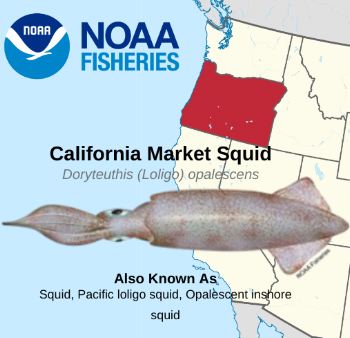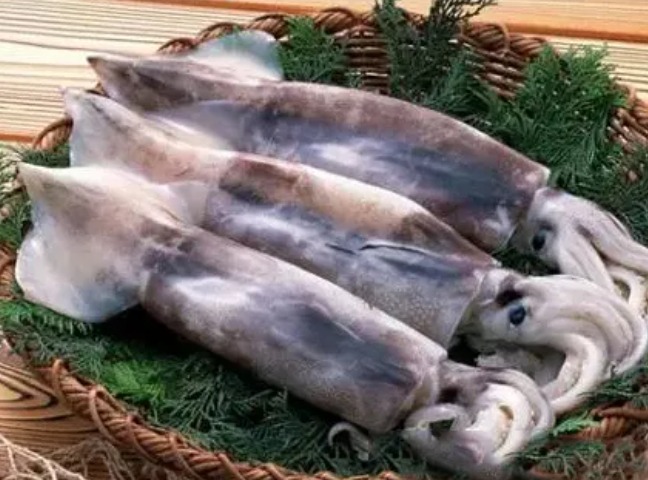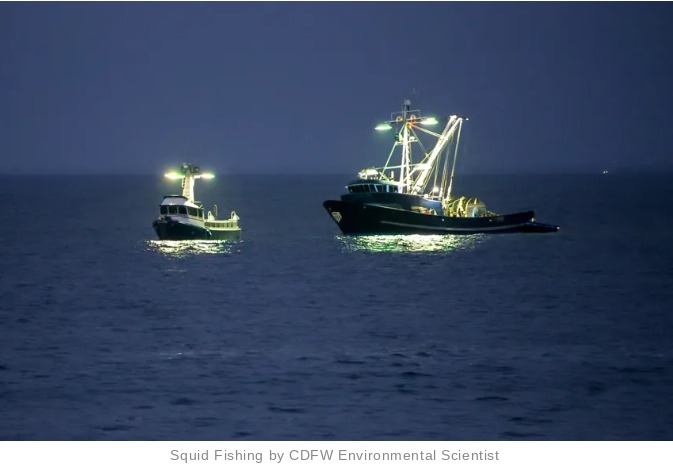|

Photo: Stockfile/FIS
As sea temperature California squid are moving further north in search of cooler waters, benefitting Oregon's fishermen
 UNITED STATES
UNITED STATES
Thursday, October 10, 2024, 07:00 (GMT + 9)
Strong demand from China means Oregon fishermen are winning without any effort!
California squid, also known as opalescent squid, California market squid, California pen squid, English name: Squid Californian, Latin: Doryteuthis opalescens, origin: Eastern Pacific Ocean south to Mexico to Alaska, most of the catch comes from California, USA.
Due to their high sensitivity to water temperature, California squid populations are heavily influenced by weather patterns, making climate phenomena a key factor in their catch rates. Historical data reveals that La Niña years typically yield abundant California squid harvests, followed by moderate La Niña periods, while El Niño years tend to be far less productive.
As oceans warm, California squid migrate north
In recent decades, warming ocean waters have contributed to a notable shift in squid distribution. Survey data indicates that squid stocks along the U.S. West Coast have doubled in the past 20 years, with schools now being found as far north as Oregon and Washington.

Opalescent squid appearance
This northward migration is part of a broader trend among marine species responding to climate change. Many commercially valuable species, such as sardines, cod, and snow crab, are also shifting their habitats, either expanding or contracting as they move to cooler waters. Scientists expect such changes to become more common as the planet continues to warm.
Interestingly, global warming appears to be benefiting squid populations. A 2016 study published in Current Biology, titled "Global Proliferation of Cephalopods," concluded that cephalopod populations have been rising globally. By analyzing data from various ocean regions, researchers found that the numbers of cephalopods—like squid—have surged over the last 60 years. This trend suggests that these ecologically and commercially significant invertebrates are adapting well to changing marine conditions.
In contrast, global warming appears to be helping the squids. In 2016, an Australian study titled "Global Reproduction of Cephalopods" published in Current Biology concluded that "cephalopod populations have increased worldwide."
.jpeg)
Analyzing data from all major ocean regions, the study authors found that cephalopod species have increased in number over the past 60 years, suggesting, they said, that " these ecologically and commercially important invertebrates may be benefiting from changing marine environments."
California Pen Squid prefers temperatures between 10°C and 16°C and usually spawns and reproduces in this temperature range. California Pen Squid usually gather in Southern California in the winter at depths of 25 to 35 meters along the Channel Islands south of California , and in the spring at depths of 20 to 55 meters along the Monterey Bay in Northern California.
Most squids only have a lifespan of about a year, and fishermen will focus on catching squids that are spawning, because the end of spawning means the end of their lives; even if there are no fishermen catching them, they will replace themselves; so ensuring that the squids caught by fishermen have already spawned is the key to ensuring the normal reproduction of squids and the stability of the future population. Therefore, changes in sea temperature usually trigger large-scale migration of squid populations.

California pen squid are fished year-round, but the main season is in Southern California during the winter, which lasts from November or December to March. The summer squid fishing season in Monterey Bay in Northern California begins in April or May and will last until October. During the summer fishing season in Southern California, the number of California pen squid is usually much lower than in the winter.
Oregon fishermen win easily
A 2022 study by Brandon Chasco, a fisheries scientist at NOAA Fisheries' Northwest Fisheries Science Center at its Newport Research Station in Oregon , showed that on the West Coast of the United States, scientists found that the number of squid increased fivefold from 1998 to 2019 from the central coast of California to the northern tip of Washington state because of marine heat waves that pushed the invertebrates farther north than where they are typically caught.
The massive northward migration of California squid populations has brought new commercial fishing opportunities to the Northwest. Oregon's squid catch has increased from zero in 2015 to nearly 5,000 tons, worth nearly $6 million, in 2020. That's still far from the size of the local Dungeness crab industry, which reached nearly $73 million in 2000, but the squid industry, which was about $6 million that year, is becoming increasingly important.
At the same time, squid harvests in California have been on a downward trend since 2016 , with harvests of 37,092 tons, 62,412 tons, 33,179 tons, 12,350 tons, and 20,450 tons in 2016-2020, respectively .
.jpeg)
Changes in China's frozen squid imports (Compiled by Haiqiao Marketing)
Chasco and other researchers from NOAA Fisheries, Oregon State University and UC Santa Cruz report on changes in squid in marine and coastal fisheries.
They note: Squid catches are notoriously unpredictable. Good years may be followed by years with lower catches. For the latter, there isn't enough research to determine if squid are actually declining or they're simply moving to where they're harder to catch. Understanding ecosystem relationships, such as the link between warming temperatures and squid abundance, could help create an "early warning system." This could help fishing communities predict and adapt to changes in fish populations and their locations.
Strong demand in the Chinese market has made American fishermen rich
California squid is a small squid, mainly replacing China's domestic squid (Chinese squid). It is usually used for fresh eating and cooking, and is very popular among residents of the southeast coast! In recent years, the demand for squid in the Chinese market has been very strong. Most of the squid from the west coast of the United States is exported to China, and the over-the-ship quotation has reached about US$1,200 per ton, which is higher than the average of US$1,000 per ton in previous years.
.jpeg)
Changes in China's frozen squid suppliers (Compiled by Haiqiao Marketing)
California Pen Squid generally has a size of 8-9 9-10 10-11 11-12 12-14 pieces per pound. It is a regular product of small-sized squid. It was previously exported to Europe, but with the increase in sales in the Chinese market, the Chinese market has gradually become the largest export country for the United States.
From the above figure, we can see how strong the demand for squid in the Chinese market is in recent years. In 2023, China's imports of frozen squid will be 350,000 tons, the same as in 2021, which is the highest level in history ; the main suppliers of frozen squid include: Peru, Indonesia, and the United States. Peru mainly exports Peruvian giant squid to China, Indonesia mainly exports Indonesian red squid to China, and the United States mainly exports California pen squid to China. Among them, Peruvian giant squid is mainly raw material for processing, part of which is used for export , while Chinese squid and California pen squid are mainly sold domestically.
Source: Haiqiao Marketing (translated from original in Chinese)
editorial@seafood.media
www.seafood.media
|



